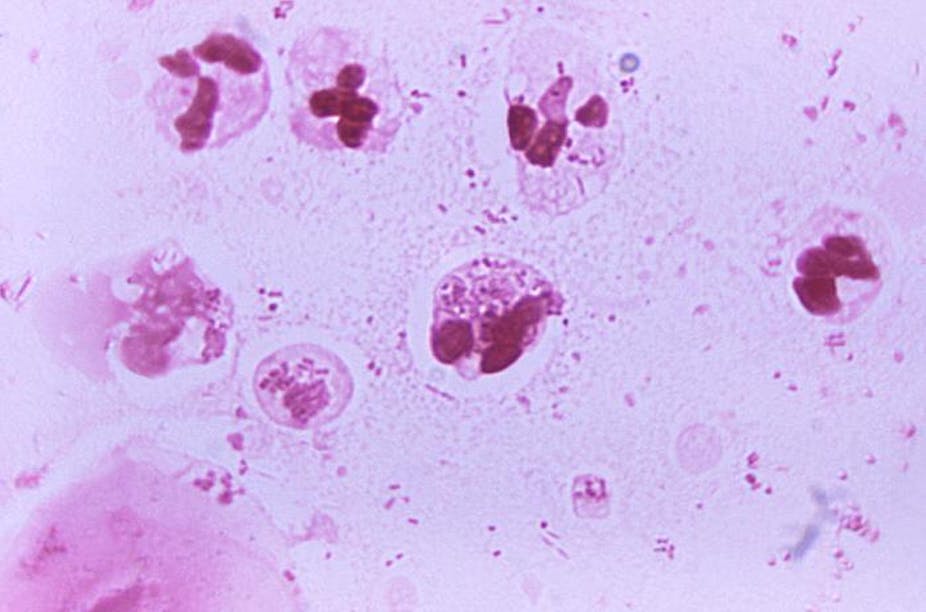FORENSICS AUSTRALIA – Thanks to television crime shows and crime novels many people are now familiar with the use of DNA as forensic evidence in criminal cases.
In these scenarios, DNA profiles are based on DNA obtained from the perpetrators or victims of crimes.
But what if the crime involves a perpetrator releasing Bacillus anthracis (causative agent of Anthrax), Yersinia pestis (causative agent of plague) or Ebola virus on to a population to create mayhem and potentially cause thousands of deaths? How do we determine the source of the micro-organism?
All living things, including humans, have genetic material (DNA or RNA – a closely related chemical molecule to DNA) as their biological blueprint.
Forensic scientists can identify genetic variations within this genetic material to provide a genetic fingerprint or DNA profile of the microbe – as is done for humans – to determine the organism’s origin.
The use of microbes as bioweapons dates back centuries from the catapulting of plague-infected decaying bodies into enemy territory to the distribution of smallpox-infected blankets by armed forces to initiate outbreaks among previously unexposed populations.
The use of bioweapons is not restricted to armies but has also been linked to cults and individuals such as the anthrax letter attack in 2001 in the US, which resulted in several deaths and provoked massive panic among the population.
In this case, Bacillus anthracis spores were placed in letters sent to various senators and media outlets in the US soon after the September 11 terrorist attacks.
Scientists obtained the genetic material from the anthrax spores in the letters and compared it against a number of known anthrax strains around the world.
The outcome from this analysis was that the anthrax strain (Ames) in the letters was most similar to a strain of the bacteria held in a laboratory in the US Army Medical Research Institute of Infectious Diseases in Maryland.
But the laboratory in this institute had sent samples of this strain to laboratories around the world prior to the anthrax attack.
The initial investigation, therefore, was unable to pin-point the exact source of the anthrax in the letters.
Fortunately, recent advances in technology allowed the identification of minority anthrax isolates found in the letters that only matched isolates found in the US Army laboratory.
The main suspect in this case, a scientist in the institute, committed suicide before evidence could be presented in court and the case was never fully resolved.

Personal biocrime
Other cases can be more personal, with some individuals intentionally transmitting a deadly virus such as HIV to another person (personal biocrime).
How can we detect the transmission of a virus between two people?
Again, HIV, in common with other microbes, has genetic material that can be profiled. But to identify specific transmission events of micro-organisms between individuals, the organism must be variable enough that one can differentiate between a recent transmission and a more distal event.
For HIV this is possible as the virus has a high mutation rate (errors made during replication of their genetic material for the next generation) – about a million times greater than humans – and has a short replication time.
This means HIV is an incredibly adaptable virus and in a single day an infected person can produce millions of new viruses that can be slightly different to each other.
This is one reason why a vaccine for HIV has so far been such an elusive goal and a DNA profile of HIV within an infected individual over time will not be the same.
Compare this to humans. Irrespective of when you get a DNA profile (at birth, during life or death) your DNA profile will always be the same.
But these features of HIV allow the scientist to identify recent donor/recipient pairs using analysis tools akin to family studies.
Viral strains that are genetically more similar to each other represent a more recent history (transmission) than viral strains that are more genetically distant.
In some instances, scientists can use a molecular clock to date a transmission event.
Our bacteria
Aside from bioweapons and personal biocrime, recent interest in microbial forensics has centred on the bacteria we carry on and in our own bodies.
There are millions of different bacterial strains living in many of our body’s compartments and latest technological advances have meant we can now sample our own commensal bacterial universe to provide a unique profile that could be used in conjunction with a DNA profile to identify an individual.
With the increased awareness of potential bioterrorism attacks, scientists are constantly striving to develop tests that allow the rapid identification of microbes and their source.
Just as DNA profiling of ourselves has become part of the routine nature of criminal cases, sampling the genetic material of microbes, either within our environment or on ourselves, will become commonplace.
This is part two of The Conversation’s Forensics Australia series. Read part one here.

